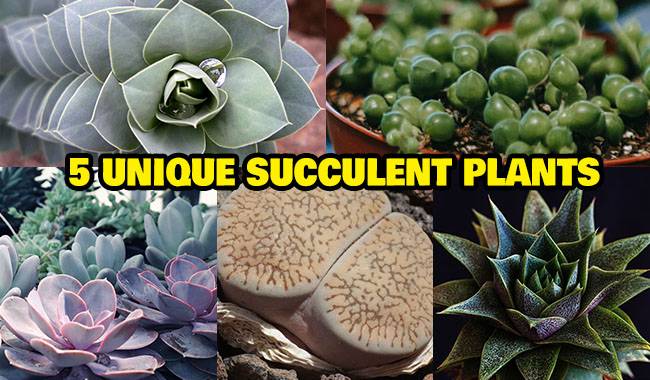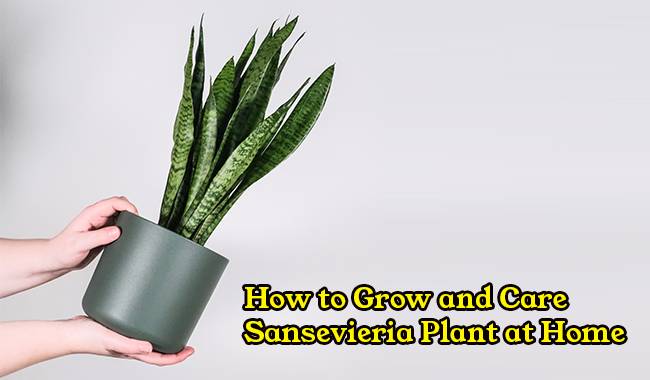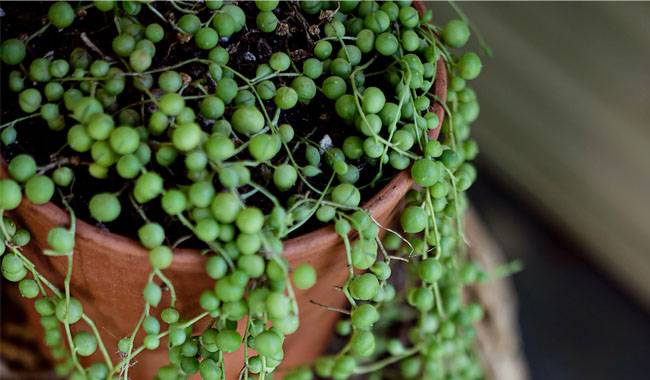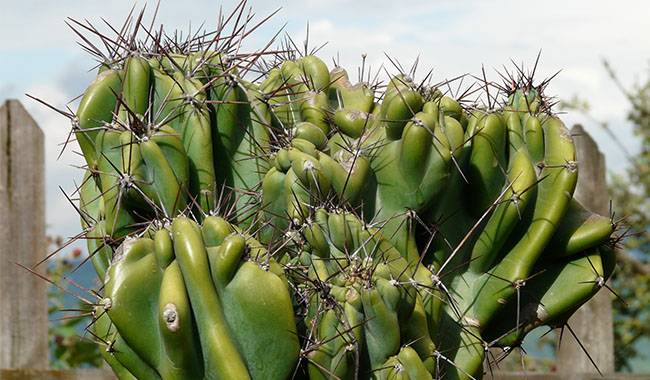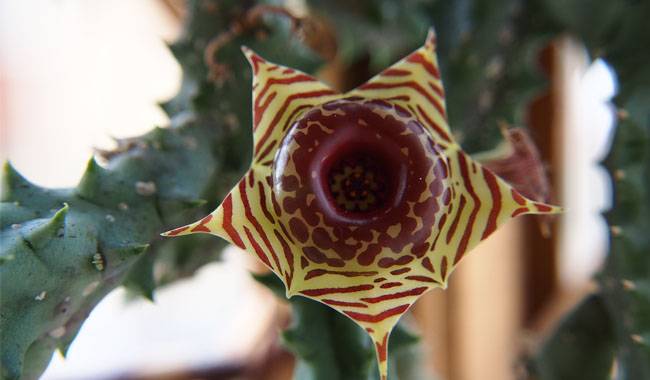
The genus Huernia is a member of the family Asclepiadaceae. According to various sources, it includes 40-60 species of plants, represented by succulents. They are found in rocky, arid regions of East and South Africa and on the Arabian Peninsula.
A characteristic feature of all species is short, branched stems at the bottom, which form rather large clumps. As a result, they can be two to three times the height of the plant itself. The thick, juicy shoots have 4-10 leaves and fleshy, sharp, conical serrations. The tips are wide at the base and can reach 0.4 inches (1 cm) in length. The bare shoots have a shiny, smooth surface and vary in color from brown to dark green.
Huernia blooms in summer and early autumn, with a flowering period ranging from 2 to 3 months. The flowers are either in small inflorescences or solitary, arranged in the lower axils of the shoots near the base (biennial or annual). The short pedicels are usually 5-20 mm long. The largely connected perianth is rich in color. They form a broad tube with five lobes with large rounded corners, and some species have pointed projections where the lobes diverge. The petals are inconspicuous and are deep inside the tube, where the reproductive organs are also present. The corolla varies in color and shape from species to species. For example, some species may have a deep cup or bell shape, while others may have a fluffy jellyfish or starfish shape. The flowers of most species give off the foul odor of fallen leaves.
HUERNIA FACTS
The genus Huernia (family Apocynaceae, subfamily Asclepiadoideae) consists of perennial stemmed succulents from eastern, southern, and Arabian Africa and was first described as a genus in 1810.
The flowers are five-lobed, usually somewhat more funnel-shaped or campanulate than the closely related genus Lithospermum, and are usually brightly striped with contrasting colors or tones, some glossy, some not, and wrinkled, depending on the species concerned. Usually, the flowers are variegated in red, yellow, or brown color. For pollination purposes, these flowers attract flies by emitting an odor similar to that of carrion. The genus is considered close to the genera Stapelia and Hoodia. Phylogenetic studies indicate that the genus is monophyletic and is most closely related to the genus Tavaresia and a broad branch of stapelias consisting of the genera Orbea, Piaranthus, and Stapelia.
The plant is named in honor of Justus van Heurne (1587-1653), a Dutch missionary, botanist, and physician who is said to have been the first European to record and collect Cape plants in South Africa. His surname has variations (van Horne, Heurnius, van Heurnius). However, it was misspelled by plant collectors.
Various Huernia species are considered famine food by the inhabitants of Konso special woreda in southern Ethiopia. Residents refer to native species of the genus indiscriminately as baqibaqa, which they eat together with prepared Turmeric; they point out that Huernia has a relatively good flavor and is consumed when cooked without unpleasant side effects. Therefore, local farmers encourage it to grow on the stone walls that form the terraces, where it does not compete with other crops.
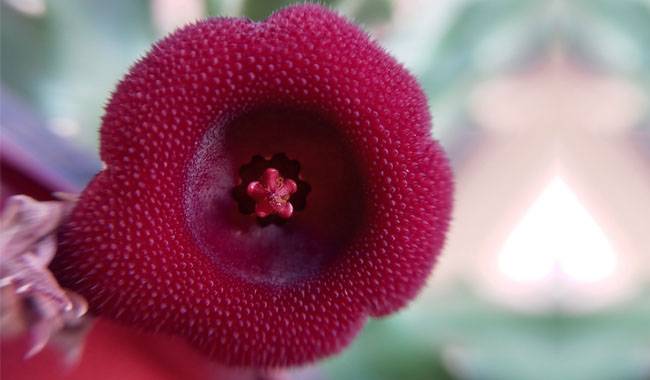
BRIEF INSTRUCTIONS FOR CULTIVATING HUERNIA
- Temperature range. In spring and summer, about 77 °F (25 °C), in autumn and winter (during rest) about 59 °F (15 °C).
- Humidity. Moderate or reduced, too humid air can provoke decay and disease.
- Lighting. Bright and diffused. Shade from direct sunlight at noon.
- Watering. Moderate in spring and summer, dry soil for short periods, sparse in winter.
- Soil. Loose, slightly alkaline. You can prepare it yourself: from sand, garden and foliage soil, peat and charcoal in the ratio 3:2:2:2:1.
- Fertilization. Under ambient conditions, Huernia does not require frequent fertilization; it is fertilized once a month during its peak growth period, requiring succulents.
- Repotting. Once a year for young plants and once every 2-3 years for older specimens.
- Propagation. By stem cuttings or by seed.
CARING FOR HUERNIA AT HOME
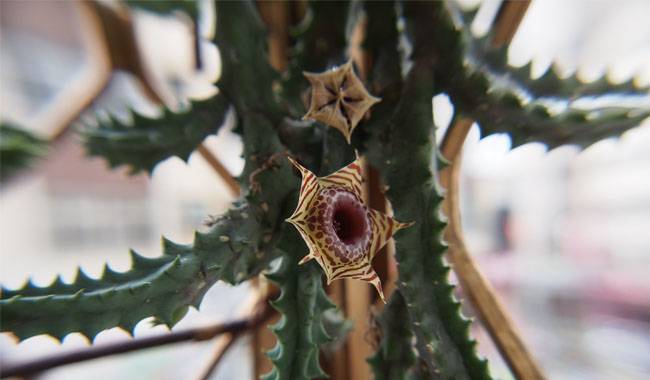
The requirements for this plant are quite low and can even be cultivated by inexperienced growers.
Light
Because it likes light, it needs plenty of light. The shrub will benefit from direct sunlight in the evening and morning. A west or east-facing window is preferable. If placed in a south-facing window, it will need to be shaded from the midday sun in summer. If the guerrilla is placed in a north-facing window, it will become slender and may not bloom due to lack of light.
In the fall and winter, the flower will need additional lighting with special plant lights.
Keep in mind that Huernia is accustomed to light at a fixed angle. This means that if the flowering plant is rotated around its axis or moved to different light intensity (brighter or darker), it will quickly discard the buds and already flowering flowers.
Temperature
In summer, such flowers usually grow and develop at 71-80 °F (22-27°C). From mid-spring to the last days of September, it is recommended to keep it outside (on the balcony, in the garden), choosing a place protected from precipitation halfway up the hill.
In winter, it will need to be cool. It is best to keep it at a temperature between 41-50 °F (5 to 10°C).
How to water
Drink moderate amounts of water in spring and summer. Huernia does not need a long drying period. The substrate needs to be systematically dried out for about 1/2. In no case should stagnant and standing water be allowed in the soil. This will cause root and stem rot and will kill the flowers in about two days.
Water sparingly in the winter.
Often at the end of the dormant period of this succulent, flower growers may experience problems with the soil drying out and not absorbing water. In this case, experienced growers recommend a tip. Pour water into a deep and wide enough container and submerge the pot in it. 20-30 minutes later (when the bubbles stop coming out), it should be removed from the water. Carefully drain off any excess liquid. Then return the flowers to their original location and water as usual during the summer months.
Humidity
This succulent is very tolerant of air humidity that is not very high, so there is no need to moisten it extra.
Soil
A suitable substrate should be permeable, friable, slightly alkaline, and have an acidity of pH 7.5-8.5. A commercial potting soil mixture for succulents can be used, but a small amount of fine gravel (3 to 4 mm in diameter) should be poured in. You can make your own potting soil. To do this, combine foliage with clay bottom soil, fine gravel, and coarse river sand.
It is recommended to use low and wide pots for planting because the plant’s root system is not well developed and will grow relatively strongly. Remember to make a good drainage layer with pebbles or expanded clay.
Fertilization
Fertilize every 4 weeks from the time the plants start to grow intensively until the end of summer. Use specialized fertilizers for succulents and cacti. Fertilization is not necessary during the stationary period.
Propagation of Huernia
Propagation is very easy using stem cuttings. Gently detach them from the mother plant and leave them outside to dry for 2 days. They are then planted in prepared potting soil. The cuttings will usually bloom in the same year.
In March, the seeds can be sown in a mixture consisting of peat and sand. Then, place the container with the seeds in a light-colored mini-greenhouse until it germinates.
Huernia transplanting
Annual transplanting in spring is recommended. Take a container with a slightly larger diameter than the previous one. Experienced growers recommend removing the old, overgrown shoots and regenerating the cuttings.
Pests and diseases
Usually, pollinators settle on such flowers and prefer loose substrates. Special insecticides (e.g., Actara insecticide) can be used to combat this pest.
The most common diseases are stem rot and root rot. If this happens, the guerrilla usually dies. Therefore water very carefully, and remember to allow a drying period.
More Related Information About Planting & Growing Indoor Plants




